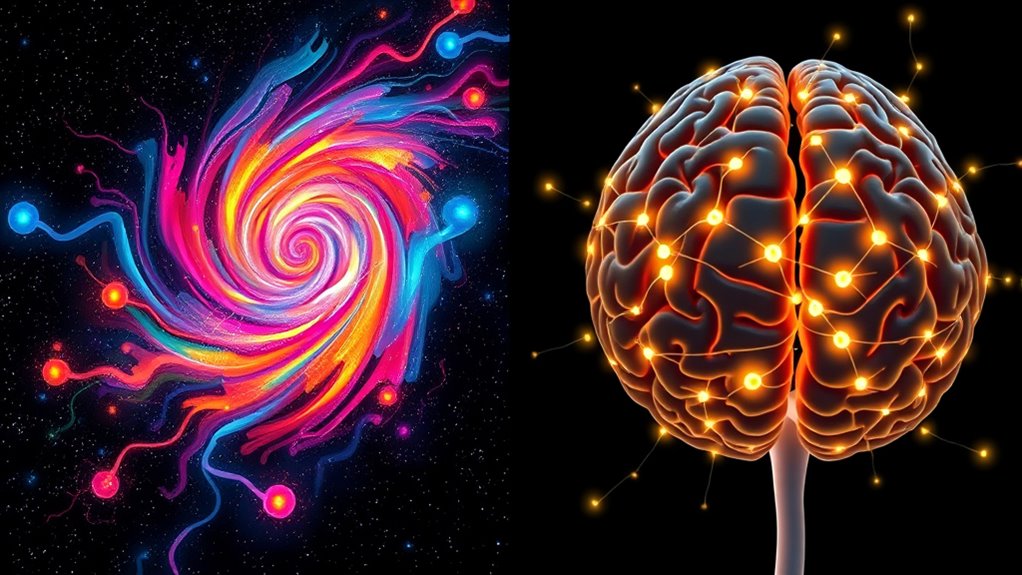The evolution of dream theories shows a shift from viewing dreams as random neural firings to seeing them as meaningful reflections of your waking life. The activation-synthesis model explains dreams as brain responses to chaotic neural activity during REM sleep, while neurocognitive models see dreams as tools for processing memories and emotions. If you explore further, you’ll discover how these perspectives continue to influence our understanding of dreams and their symbolic significance.
Key Takeaways
- The activation-synthesis model emerged as a neurobiological explanation emphasizing random neural activity during REM sleep.
- Neurocognitive models evolved to highlight dreams as meaningful reflections of waking life and memory processing.
- Initially, dreams were viewed as symbolic expressions, but theories shifted from randomness to function and purpose.
- Modern perspectives integrate both models, recognizing dream symbolism’s role in emotional and cognitive processing.
- Theories continue to evolve, with current research exploring how conscious awareness, like lucid dreaming, bridges the models.

Dreams have long fascinated scientists and laypeople alike, prompting numerous theories about their origins and functions. Among these, the activation-synthesis model and neurocognitive models stand out as two of the most influential explanations. As you explore these theories, you’ll find that they offer contrasting views on why we dream and what purpose dreams serve. The activation-synthesis model suggests that dreams are the brain’s way of making sense of random neural activity during REM sleep. When your brainstem activates your sensory and motor areas, your brain attempts to synthesize this chaos into a coherent story, which you experience as a dream. This process explains why dreams can often feel strange or disconnected, and it emphasizes the role of random activation rather than meaningful content. However, some dream researchers believe that the brain’s effort to interpret this activity results in the vivid imagery and symbolism you notice in dreams — what we call dream symbolism. For example, when you dream of flying or falling, these images might symbolize feelings of freedom or insecurity, tapping into your subconscious thoughts. Lucid dreaming, where you realize you’re dreaming while still asleep, adds an interesting twist to this process. It suggests that you can sometimes consciously influence or even control your dreams, revealing that dreams may also serve as a space for self-awareness and psychological exploration. From a neurocognitive perspective, dreams are seen as a reflection of your waking life, processing memories, emotions, and problem-solving efforts. This model emphasizes that dreams often incorporate elements from your daily experiences, making them more meaningful. You might dream about a stressful day at work or a joyful event, which helps your brain consolidate memories and emotional experiences. This approach also supports the idea that dreams can be a form of mental rehearsal, allowing you to practice responses or work through unresolved conflicts. Both models acknowledge the importance of dream symbolism, but they differ on how much of it is driven by random neural activity versus deliberate psychological processes. Activation-synthesis sees symbolism as a byproduct of random activation, while neurocognitive models view it as a meaningful reflection of your subconscious mind. As you think about lucid dreaming, it becomes clear that your awareness during dreams can offer insights into your mind’s workings, bridging the gap between these theories. Whether dreams are random fireworks or meaningful narratives, they continue to intrigue and inspire scientific inquiry into the mysterious landscape of your subconscious mind. Additionally, ongoing research into dream symbolism aims to better understand how the brain creates symbolic content and its connection to emotional processing.
Frequently Asked Questions
How Do Cultural Differences Influence Dream Interpretation?
You notice that cultural differences greatly influence how you interpret dreams. Cultural symbolism shapes the meaning you assign, making certain symbols or themes more significant based on your background. This leads to interpretative diversity, where your cultural lens affects what you see in your dreams. Your cultural beliefs and practices help you understand your dreams differently, emphasizing the importance of context in dream analysis and how cultural background shapes your perception of dream content.
Can Dreams Be Used for Psychological Therapy?
Yes, dreams can be used for psychological therapy. You can explore lucid dreaming to gain awareness and control within your dreams, helping you confront fears or unresolved issues. Keeping a dream journal allows you to track patterns and uncover insights. By actively engaging with your dreams, you enhance self-awareness and emotional processing, making therapy more effective and personal. This approach empowers you to understand and heal your subconscious mind.
What Role Does Genetics Play in Dreaming?
Genetics play a significant role in dreaming by influencing your sleep patterns and emotional responses. Your genetic predispositions and hereditary influences can shape how often you dream, the themes you experience, and how vividly you recall your dreams. These inherited traits affect brain structures involved in dreaming, making some individuals more prone to certain dream content or frequency. Understanding your genetic background can help explain why your dreams feel uniquely personal.
Are There Differences in Dreaming Across Age Groups?
You might notice that children dream more vividly and recall their dreams more often than adults. Developmental changes influence dreaming, with dream complexity and recall decreasing with age. As you grow older, your brain’s ability to remember dreams diminishes, making dream recall less frequent. This shift reflects changes in brain development and memory processes, highlighting how age impacts your dream experiences across different life stages.
How Does Sleep Environment Affect Dream Content?
Your sleep environment substantially influences your dream content. A calm, quiet sleep setting helps you relax, leading to more vivid and positive dreams. Conversely, a noisy or uncomfortable dream environment can cause fragmented or stressful dreams. Factors like lighting, temperature, and bedding also impact your sleep quality, shaping the nature of your dreams. Creating a peaceful sleep setting promotes healthier, more enjoyable dream experiences.
Conclusion
As you drift through sleep’s quiet landscape, imagine your brain as a bustling city, lights flickering with random sparks of activity. The activation-synthesis theory suggests your mind weaves these sparks into stories, like a painter blending colors without a plan. Meanwhile, neurocognitive models see dreams as reflections of your waking thoughts, shaping a vivid mirror of your mind’s workings. Both theories invite you to explore the mysterious, swirling tapestry of your dreams—where imagination and cognition dance together in the night.









